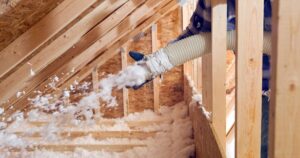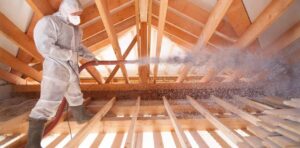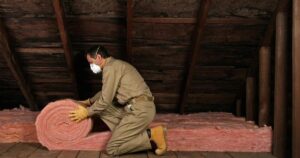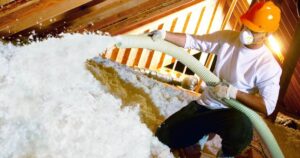When it comes to insulating the floor of a raised house, there are several solutions available. Insulating the floor can help improve energy efficiency and comfort, and reduce heating costs.
In this article, we will explore the different options for insulating the floor of a raised house, their costs, and the step-by-step process for each method.
Insulating under a raised house is essential for energy efficiency and climate control. This process involves adding insulation material beneath the floor of the house, which can help regulate indoor temperatures and reduce heating and cooling costs
Should You Insulate the Floor of a Raised House?
Before diving into the insulation options and costs, it’s essential to consider whether insulating the floor of your raised house is necessary. Insulating the floor can be a wise investment if you want to:
- Improve energy efficiency: Insulating the floor helps keep your home warmer in the winter and cooler in the summer, reducing energy bills.
- Enhance comfort: A well-insulated floor makes your home more comfortable, preventing drafts and cold spots.
- Prevent moisture and mold issues: Insulation can help control moisture, which is crucial in raised houses, especially in damp environments.
Insulate The Floor of a Raised House Step By-Step
Now that you’ve decided to insulate the floor, let’s explore the two primary insulation options: Spray Foam and Fiberglass Batts.
Option 1: Spray Foam
Spray foam insulation is a popular choice for insulating the floor of a raised house due to its effectiveness and versatility.
Pros of Spray Foam:
1. High R-value: Spray foam provides an excellent insulation value, keeping your home comfortable.
2. Air and moisture barrier: It acts as an air and moisture barrier, preventing drafts and moisture-related problems.
3. Versatility: Spray foam can seal even the most challenging gaps and cavities.
Things to Remember:
- Professional installation is recommended for best results.
- Ensure proper ventilation when using spray foam.
- Check local building codes for compliance.
Step-by-Step Application Process:
1. Mix the Foam:
- Prepare the spray foam mixture as per the manufacturer’s instructions.
2. Prepare the Spray Foam Gun:
Attach the foam gun to the mixing unit.
3. Test the Sprayer:
- Test the spray foam gun to ensure a consistent flow.
4. Apply the Foam:
- Spray the foam evenly on the underside of the floor.
5. Let the Foam Dry:
- Allow the foam to cure and dry completely.
Option 2: Fiberglass Batts
Fiberglass batts are a traditional, cost-effective insulation option.
Pros of Fiberglass Batts:
1. Cost-effective: Fiberglass batts are budget-friendly.
2. DIY-friendly: You can install fiberglass batts with some DIY skills.
3. Fire-resistant: Fiberglass is non-combustible.
Things to Remember:
- Wear protective gear when handling fiberglass batts.
- Ensure a snug fit without gaps for optimal insulation.
Step-by-Step Application Process:
1. Cut the Batts:
- Measure and cut fiberglass batts to fit the space between floor joists.
2. Install the Batts:
- Insert the batts between the floor joists, ensuring a snug fit.
3. Repeat:
- Continue this process for all the gaps.
- Consider hiring a professional for spray foam insulation.
- Ensure proper ventilation to prevent moisture issues.
- Check your local building codes and regulations.
Can I Use Blanket Insulation In a Basement?
When it comes to insulating a basement, you might wonder if using blanket insulation is a suitable option. Blanket insulation, which typically comes in the form of rolls or batts, can be used in basements. However, there are some important considerations to keep in mind. Basements tend to have unique moisture challenges, so using the right type of blanket insulation and ensuring proper installation is crucial.
Blanket insulation is typically made of fiberglass or mineral wool, and it’s a good choice for basement insulation because of its thermal and sound insulation properties. However, it’s essential to select the right R-value for your insulation, as this will determine its effectiveness in keeping your basement warm and dry.
When using blanket insulation in a basement, consider the following tips:
1. Moisture Control: Basements are prone to moisture, so it’s essential to manage this issue. Before installing blanket insulation, make sure your basement is adequately sealed and waterproofed. Moisture can degrade the insulation and create a conducive environment for mold growth if not addressed properly.
2. Vapor Barrier: Use a vapor barrier in conjunction with blanket insulation to prevent moisture from entering the insulation. This barrier should be placed between the insulation and the interior wall, with the vapor-retarder side facing the interior.
3. Installation: Ensure that the insulation is installed snugly without gaps. This helps maintain its thermal efficiency. Use a staple gun or other appropriate fasteners to secure the insulation to the basement walls or ceiling.
4. Fire Safety: Be aware of fire safety considerations. Some insulation materials may have fire-resistant qualities, while others may require additional fireproofing measures.
9 Spray Foam Insulation Benefits That Make It a Great Choice
Spray foam insulation is a popular choice for insulating various parts of your home, including the floor of a raised house. Here are nine benefits that make it a great choice:
1. Excellent Insulation: Spray foam has a high R-value, providing superior insulation compared to traditional materials like fiberglass.
2. Air Sealing: It acts as an air barrier, sealing cracks and gaps, reducing drafts, and improving energy efficiency.
3. Moisture Control: Spray foam can help prevent moisture-related problems by creating a barrier against water vapor.
4. Versatility: It can be used in various applications, including attics, walls, and floors.
5. Longevity: When properly installed, spray foam insulation can last for the life of the building.
6. Sound Insulation: It provides effective soundproofing, reducing noise from outside and between rooms.
7. Energy Savings: Due to its superior insulation properties, it can significantly lower heating and cooling costs.
8. Eco-Friendly: Some spray foams are formulated with environmentally friendly materials and have low VOC emissions.
9. Durable: Spray foam can resist pests and does not settle or deteriorate over time.
What Are Some Alternatives to Spray Foam Insulation In Attic?
While spray foam insulation is an excellent choice for attics due to its air-sealing and insulating qualities, there are alternatives you can consider:
1. Fiberglass Batts: Similar to the option mentioned earlier for insulating the floor of a raised house, fiberglass batts can be used in attics. They are cost-effective and relatively easy to install.
2. Cellulose Insulation: Made from recycled paper products treated with fire-retardant chemicals, cellulose insulation is another environmentally friendly option. It can be blown into attic spaces.
3. Rigid Foam Insulation: Rigid foam boards can provide insulation and also act as an air barrier. They are effective in both warm and cold climates.
4. Mineral Wool: This type of insulation, made from minerals and recycled materials, is fire-resistant and provides good thermal and sound insulation.
Conclusion
When insulating your raised house or attic, it’s essential to consider the specific needs and conditions of your space. While spray foam insulation offers numerous benefits, alternatives like fiberglass batts, cellulose, rigid foam, and mineral wool can be suitable choices depending on your budget and insulation requirements. Always consult with a professional to determine the best option for your home.
insulating the floor of a raised house can lead to improved energy efficiency, comfort, and moisture control. The choice between spray foam and fiberglass batts depends on your budget and needs. Always consider professional installation for the best results and consult local building codes to ensure compliance.










